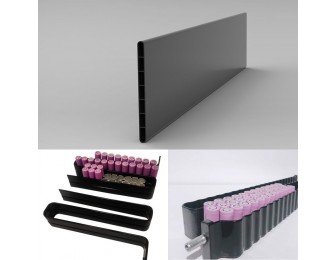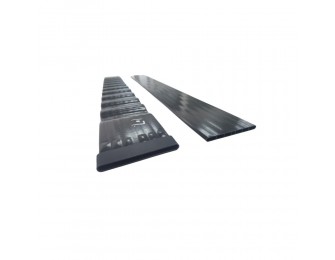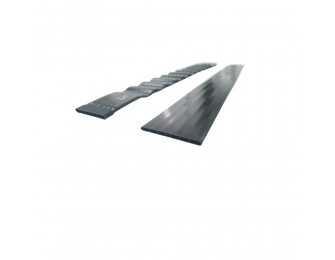Heat conductive PPS or PA12 pipe for EV Battery Cooling
PA12 / PPS for EV Battery Cooling
Extruded by technology of KXT-E3 lines from Jiangyin KAXITE company in China, realized the high precision (0.7mm thickness) as well as a perfect 2nd times molding process for a wavy shape, to get a better fitment with the batteries in electric vehicle.
Advantages of the heat conductive PA12 & PPS pipe:
- Lower density, lighter and lower cost than aluminum;
- Good insulation and toughness;
- The modified material has good thermal conductivity and heat dissipation;
- KAXITE high-precision extrusion process;
- More than 40 production lines ensure that the demand is met;
- highly resistant to acids, bases, solvents and other corrosive substances across its operation temperature range and for extended periods of time;
- Longer service life;
To better understand manufacturing challenges and solutions when it comes to electric vehicle batteries, let’s go over the following subjects:
-->EV Battery Cooling Methods
EV batteries can be cooled using air cooling or liquid cooling. Liquid cooling is the method of choice to meet modern cooling requirements. Let’s go over both methods to understand the difference.
Air Cooling
Air cooling uses air to cool the battery and exists in the passive and active forms.
Passive air cooling uses air from the outdoor or from the cabin to cool or heat the battery. It is usually limited to a few hundred watts of heat dissipation.
Active air cooling gets its air intake from an air conditioner, which includes an evaporator and a heater to control the air’s temperature. It is usually limited to 1kW of cooling and can be used to cool or heat the cabin.
Liquid Cooling
Liquid cooling is the most popular cooling technology. It uses a liquid coolant such as water, a refrigerant, or ethylene glycol to cool the battery. The liquid goes through tubes, cold plates, or other components that surround the cells and carry heat to another location, such as a radiator or a heat exchanger. Components carrying the liquid prevent direct electrical contact between the cells and the liquid coolant.
Like air cooling, passive and active systems exist. Active liquid cooling is more complex and expensive but provides better performances such as propulsion and charging power. The difference between active and passive cooling is that passive cooling uses ambient air to control the liquid’s temperature, whereas
Some thermal management systems use a direct-contact medium such as oil or other dielectric liquids that are directly in contact with the cells. This is mostly used in non-consumer EVs, as they are less safe and provide a less effective insulation between the cells and the surrounding environment.
Cooling Methods Over Time
Nowadays, most batteries are liquid cooled using active cooling, as it allows better control over the temperature. Liquids are better heat conductors than air—hundreds of times better to be precise—which facilitates temperature management.
Because batteries were much more expensive to produce at the beginning of the EV revolution, manufacturers were doing everything to minimize production costs, which made passive air cooling more attractive. But battery costs have dropped over the last decade, and quick charging, which has more demanding cooling requirements, has gained in popularity. As a result, the passive air-cooling technology has lost its popularity.
At the beginning of the 2010s for example, you had two options for about the same price: a Nissan Leaf with air cooling and a longer-range battery, or a Chevy Volt with active liquid cooling but a lower range yet more powerful battery. A high range, powerful battery that was actively cooled would have been too expensive at the time.
One of the reasons why active cooling is more expensive is that it includes more components, such as a heat pump, a heat exchanger, a circulating pump, valves, and multiple temperature sensors. However, the cooling results are much more reliable.
-->Why EV Batteries Need to Be Cooled
EV Batteries have specific operating ranges, which are critical for the battery life and performance. They are designed to operate at ambient temperature, which is between 68°F and 77°F (20°C and 25°C). A better control over the battery temperature improves their performance and life.
- During operation, they can withstand temperature between -22°F and 140°F (-30°C and 50°C)
- During recharges, they can withstand temperatures between 32°F and 122°F (0°C and 50°C)
Batteries generate a lot of heat during operation and their temperature must be brought down within operating ranges. At high temperatures (between 158°F and 212°F, or 70°C and 100°C), thermal runaways can occur, causing a chain reaction that destroys the battery pack.
During fast charges, batteries must be cooled down. This is because the high current going into the battery produces excess heat that must be extracted to preserve the high charging rate and not overheat the battery.
They sometimes also need to be heated up when the temperature is too low or to boost performances. For example, cells cannot be charged below 32°F (0°C). Or, companies like Tesla offer battery preheating in some models to reach high performances, going from 0 to 60 mph in less than 2 seconds.
-->Thermal Management Challenges
The most common thermal management challenges for EV batteries are leaks, corrosion, clogging, the climate, and aging. As you will see, liquid cooling systems present challenges that are inexistent for air cooling systems.
- Leaks can only occur in liquid cooling systems, whose pipe connections have risks of leaks as the battery ages. Any leaks will rapidly degrade the battery performance and life. They can even cause the EV to stop operating if humidity attacks the battery’s electrical insulation. Battery modules, interconnections, pumps, and valves must all remain intact.
- Corrosion can only occur in liquid cooling systems, whose cold plates can corrode as the liquid glycol gets older. Therefore, the cooling liquid must be replaced as part of the vehicle’s maintenance.
- Clogging is a risk that is present in the hundreds of small channels where liquid travels in the battery.
- Climates around the globe pose different thermal challenges for batteries. Examples include leaving the car under heavy sun for a long time, or living in a place where there are extremely low temperatures in winter. Batteries must be able to tolerate wide temperature ranges at all times. To achieve this, the battery cooling system must be active even when the vehicle is not in use.
- Aging causes thermal management problems that must be planned for. As batteries get older, a larger portion of energy is loss as heat. The thermal management system must be built for these tougher conditions that occur later in the battery life, not just for typical conditions during the first years.
-->Examples of Battery Thermal Management Systems
The following schemas show thermal management systems in well-known electric vehicles.
Nissan
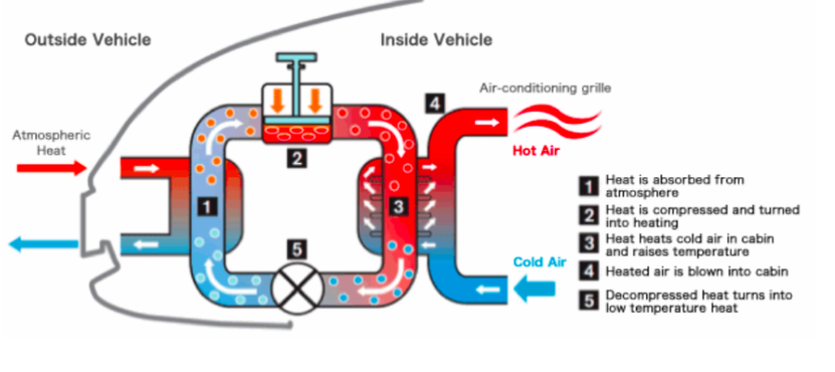
More info: Nissan Leaf’s cooling system
Chevrolet Volt
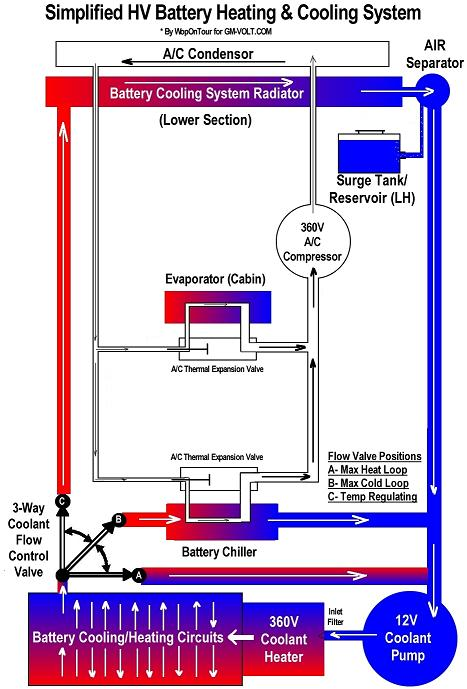
More info: Chevy Volt’s cooling system
Tesla Model 3
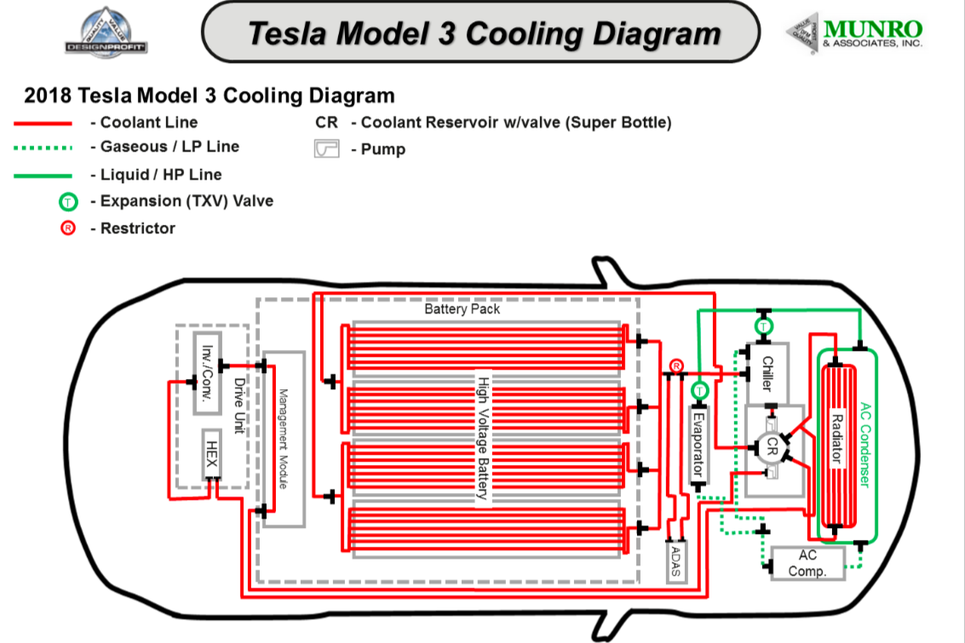
More info: Tesla Model 3’s cooling system
(Note: content above was sourced from https://www.laserax.com/blog/ev-battery-cooling#why-need-to-be-cooled )

